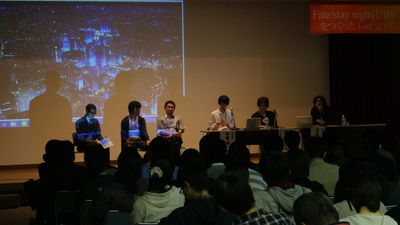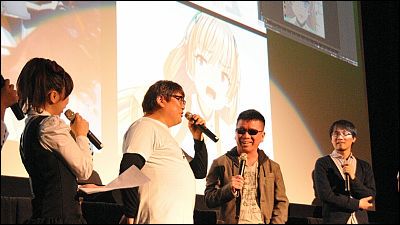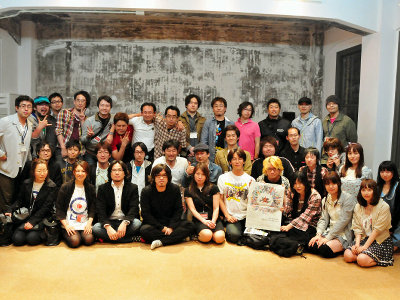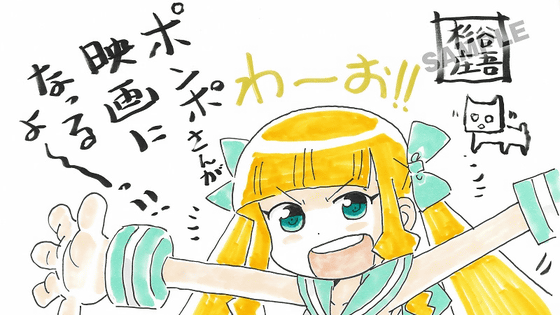What exactly does 'filming' involve to enhance the quality of anime? A report from the 'TROYCA Anime Filming Roundtable Discussion' with anime filming professionals at Machi★Asobi Vol. 29

In anime production, not only are there directing and drawing, but 'filming,' in which footage is processed and composited to create the final screen, is also an important process. TROYCA, an animation production studio known for anime such as '
Machi★Asobi Vol.29
https://www.machiasobi.com/
TROYCA Anime Filming Roundtable
https://www.machiasobi.com/event/404/
The speakers were Tomoyoshi Kato (left) and Ryosuke Tsuda (right). Kato is one of the founding members of TROYCA, serves as the chief director of the digital video department, and has worked as a cinematographer on a variety of productions. Ryosuke Tsuda is not only a cinematographer, but also sometimes handles visual effects. What is the difference between cinematography and visual effects? This will be discussed later.
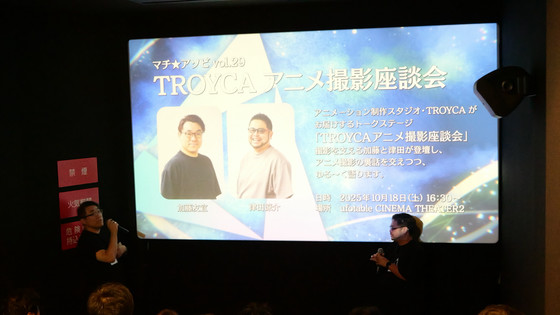
TROYCA is an animation production studio founded in 2013 by Toshiyuki Nagano, Kato, and Ei Aoki, known for directing
Kato and Tsuda had worked at the same company before the founding of TROYCA, and Tsuda later worked on effects production for 'Evangelion: 3.0 You Can (Not) Redo' as part of Studio Khara's special effects team. He then joined TROYCA. Although Tsuda did not participate in 'Hōrō Musuko' as a cinematographer, it is said that he devised the prototype for the process of moving images with a watercolor-like texture.

Examples of works produced by TROYCA in which the two worked together include: 'Aldnoah.Zero,' 'Re:CREATORS,' and ' Overtake! ' Kato was the cinematographer and Tsuda was in charge of visual effects. In other works, it seems that only one of them was the cinematographer.
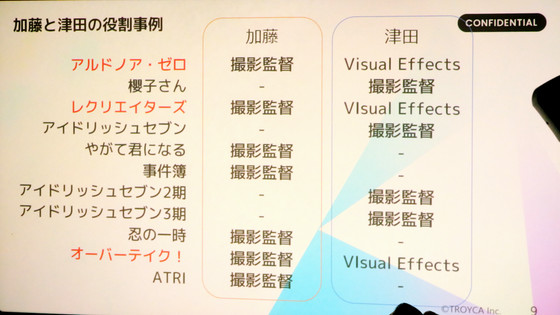
According to Kato, the role of cinematographer is essentially one that should specialize in creativity, but in reality, they are limited to managing cuts and giving instructions, which means that the quality of the work cannot be improved. Even so, the reason why Kato and Tsuda do not both serve as cinematographers at the same time is because there is a risk that they will not compromise on certain points and clash. For this reason, they separate the roles into two, cinematographer and visual effects director, and while they consult with each other about more difficult visuals, they often divide the roles in this way: 'Kato handles the everyday aspects and Tsuda handles the battle scenes.'
Kato called Tsuda when they were working on 'Aldnoah.Zero.' According to Tsuda, Kato invited him because 'there aren't that many battle scenes,' so he thought that was fine and decided to join, but he was surprised to find that there was constant fighting towards the end.
Tsuda was the sole cinematographer for ' There's a Corpse Buried Under Sakurako's Feet ' and 'Idolish Seven.' He apparently became involved with 'Idolish Seven' because a friend from his university days was involved in the game version. Tsuda also worked on Makoto Shinkai's films around the time Kato was in charge of cinematography for ' Bloom Into You ,' and was a cinematographer on 'Your Name' and cinematographer on 'Weathering With You.' He also participated as cinematographer in the production of 'Sparrow's Door Lock' during the latter half of the production period for 'Idolish Seven Third Beat!'.
The first part of the animated film ' Idolish Seven First BEAT! Theatrical Compilation, ' which is a compilation of 'Idolish Seven (Season 1),' was released on Friday, October 3, 2025.
'Idolish Seven First BEAT! Theatrical Compilation' Official Trailer | [Part 1] Released on Friday, October 3rd, [Part 2] Released on Friday, December 5th! - YouTube
The animated feature features the TROYCA logo. Regarding the concept behind this logo animation, Tsuda said, 'Since we were a company founded by three people, we were thinking of three lights coming together! But when we tried to create a hand-drawn look, it seemed to resonate with Aoki. So we proceeded with the production with the concept of a blend of the hand-drawn animation department and the digital department using noise.'

Next, we asked Tsuda about his favorite scenes. The first is the scene in 'Re:CREATORS' where the room breaks down into blocks. You can see that scene from around 27 seconds into the promotional video below.
To begin with, 'filming' is flat, meaning that 2D images are processed using software such as Adobe After Effects. However, this scene was processed using 3D software using 3D layout data of the room. According to Kato, this processing is a fine line between being called 'filming' and being exactly 'visual effects.' Tsuda said, 'This is a scene that represents the work of visual effects, so I think it was well done.'
The second is a live scene from 'Idolish Seven,' which includes a shot captured from the stage of the audience waving colorful penlights.
When looking at the audience from the stage, you can see many people waving penlights. Tsuda said, 'It's cool to have light in the dark. We also took care to make the light from the penlights reflect off the audience, and I think it worked well because the penlights look like they're actually shining.'
The next favorite scene that Kato introduced was from the bonus footage 'Fragments of Rain' included in the Blu-ray box set of 'Aldnoah.Zero,' where Kaizuka Inaho and Calm Craftsman are driving in a car in the rain.
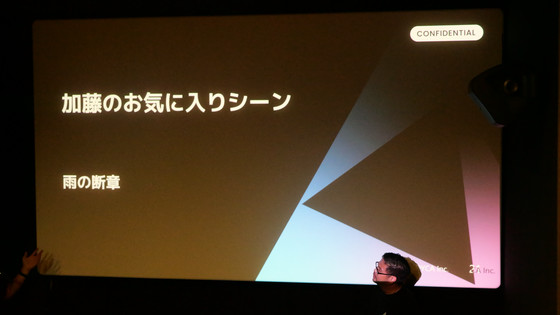
In the scene where Calm says, 'The wipers won't be able to stop in time,' his face is seen through the windshield, and at this moment, raindrops falling on the windshield and the wipers wiping them away are also visible. In reality, if it rains so much that the wipers can't stop in time, the rainwater clinging to the windshield would distort the driver's face. However, it would be very problematic for the character's face to be distorted and become invisible in the animation, so Kato said, 'I lied about the animation here.'
So, when the windshield wipers wipe away the rainwater, the water quickly recedes, and then raindrops hit it. This allowed for both the intensity of the rain and the character's face to be captured, but the rainwater recedes so quickly that the animation team complained, 'The oil film on this windshield is too strong.' At the time, they explained the lines and were convinced, but when they were creating the looped footage for the event materials, they came to the conclusion that 'the oil film is really strong...' and were once again amazed at the animation staff's 'power of observation.'
Kato said, 'What you see with your own eyes influences what you create, so I tell young people to see it with their own eyes. Nowadays you can see it on YouTube, but I still want them to see it with their own eyes.' Tsuda added, 'It's true, isn't it? When there's a heavy snowfall, everyone is happy to go and see it (laughs).'
The conversation also turned to each other's work. When Kato had some free time on 'Aldnoah.Zero,' he checked the footage that Tsuda had processed and noticed that it had many complex layers stacked on top of each other, so he secretly removed some that he thought were unnecessary. Later, the footage was properly restored to its original state. Tsuda commented, 'I take pride in my work (laughs).'
Furthermore, the second part of the 'Idolish Seven First BEAT! Theatrical Compilation,' due for release on Friday, December 5, 2025, is a compilation of the first season of the TV anime. However, when footage from previous works needs to be re-shot, there are cases where 'the data is too old to open.' This is an issue that arises when the software used in-house is updated or replaced, and Kato stated that this is a concern for the future. In response, Tsuda said, 'I guess in the end, the only option is to recreate it with our eyes. Also, when I look at footage from previous works, I feel like I want to fix it. I think, 'I did it this way back then, but I would do it this way now!''
At the end of the event, there was a Q&A session with the audience. One audience member who is a fan of 'Re:CREATORS' asked, 'Each work that appears has a different setting and distinctive artwork, but have you ever tried to differentiate between them in terms of cinematography effects?' To this, Kato replied, 'That's a great question.'
TV anime 'Re:CREATORS' 1st PV-YouTube
According to Tsuda, who was in charge of visual effects for 'Re:CREATORS,' 'I have a concept in mind.' The settings for a work usually don't include the effects, and he is often told to 'just have the cinematographer make it look good.' For example, in 'Aldnoah.Zero,' the visual effects were separated for the Earth and Mars sides, with the Earth side using effects that were connected to current technology, while the Mars side had a fantasy-like image and included effects that were close to vibrant colors.
When asked by Kato, 'Did you receive any instructions from the director?', Tsuda replied, 'It's completely a background setting in my mind (laughs). If I had told the director, I think he would have been like, what are you talking about?'
In response to the question, 'Have the cinematography team ever made suggestions to the animation team that were reflected in the animation?', Kato replied, 'It's true that at TROYCA, the animation team and the digital team are all on the same floor, so we can consult with each other, but although the animation team will ask us, 'What should we do?', they may not ask us to do anything in the animation department.' On the other hand, Tsuda commented, 'I think it's fine to use the materials that come up and make them in the best possible condition at the time. This may be a different stance from Kato's.'
Kato says that cinematography is based on the animation, and since cinematography is about adding something to that, he prioritizes the intentions of the animators. He also says that digital cinematography can be particularly problematic in that it can be difficult to convey the image, and that when there's really no other option, they sometimes do tests first, but most of the time he consults with the director rather than the animation team.
TROYCA has previously published a book called 'TROYCA-Style Anime Filming Techniques : Deciphering 10 Years of Cuts,' which explains over 50 cuts from 11 works, including the 'Idolish Seven' series, 'Aldnoah.Zero,' and 'The Case Files of Lord El-Melloi II . ' The book's content has been well-received, with overseas staff even asking, 'Where can I buy it?' However, at the time of writing, the book has not been reprinted and is only available in stores.
Related Posts:
